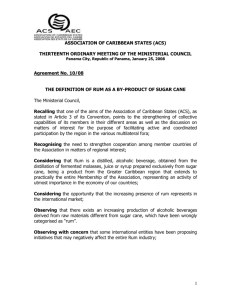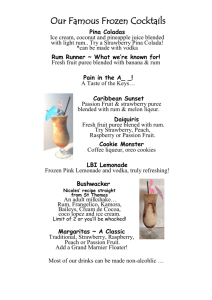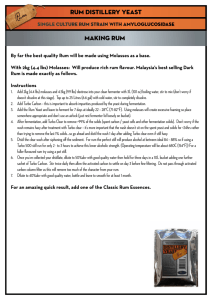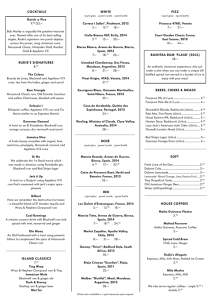RUM - Food and Beverage
advertisement
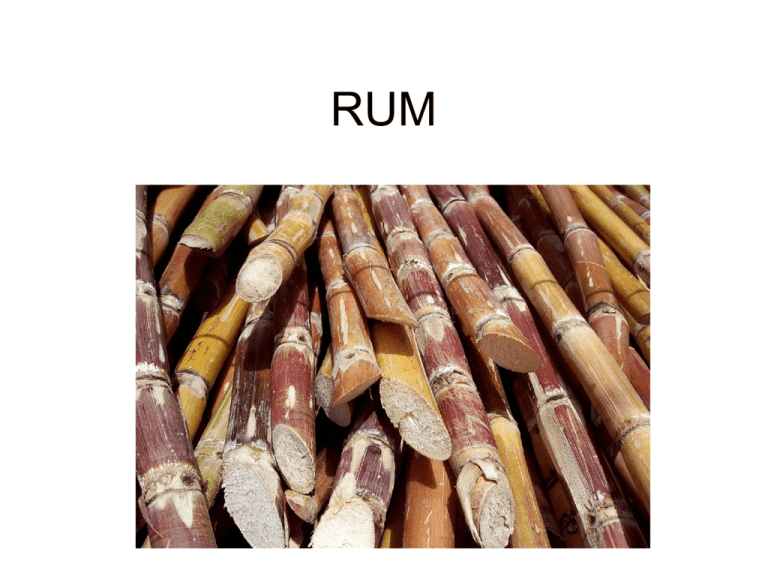
RUM DISTILLATION • • • • BASE INGREDIENT WATER YEAST FLAVOURINGS RUM • • • • • • • • • • • • • • • • • • • Juicing (by crushing or pressing) for fruits or other sugary bases to extract their liquid Malting Milling Mashing for grains Malting — The grain or starch is moistened and heated slightly to launch germination (“sprouting”), which causes the grain’s starches to convert to fermentable sugars. Milling — After malting, the grain is milled into smaller pieces to expose the sugars. Mashing — The milled grain or starch is heated with water then Fermenting Distilling Aging (optional) • • • • • • • • • • • • Aging Many spirits are aged in casks (usually of oak), to mellow, harmonize and flavor the spirit. Which spirits are aged? Some spirits, like whisk(e)y and Cognac, are always aged, while others, like rum and tequila, may or may not be aged. Vodka is seldom, if ever, aged. Because the cask aging also imparts a coppery or golden-brown color, spirits aged in this way are commonly called “brown goods.” Why barrels? Traditionally barrels were used for convenience and durability during shipping. But it soon became clear that, as with wine, barrel aging could mellow and improve the taste of the spirits shipped therein. Gradually barrel aging became an important factor in the style of many spirits. Modern distillers are very particular about the barrels they use. Here’s what the distiller has to decide when it comes to barrel aging: Old barrels or new? Some spirits are aged in new white oak barrels, while for others, used barrels are employed. A new oak barrel will impart more flavor to the spirit, a used barrel less flavor. Spirits produced in continuous stills, which are usually lighter, are often aged in new oak barrels. Spirits produced in pot stills, which are generally more flavorful, are usually aged in used oak barrels, whose flavor is less strong. Barrels whether new or used may be charred to add a smoky, toasty flavor and aroma. How much time in the barrel? Spirits may be barrel aged for anywhere from just a few months, to several decades. RUM • • • • • • • • Profile - Rum production began in the Caribbean, following the introduction of sugar cane to the region by Christopher Columbus. It originally developed as a way to use molasses, the byproduct of sugar production. The original rums were heady and rich, retaining much of the burnt sugar flavor profile of the molasses base. Ingredients: Nowadays, rums may be distilled from molasses (the byproduct of production of sugar from cane), free run sugar cane juice, or cane syrup. Production: Rum is made throughout the Caribbean as well as many other sugar canegrowing regions of the world including: Argentina, Brazil, Cuba, Indonesia,,Peru, the Philippines, and even Hawaii. Light rums are usually produced in continuous stills, though pot stills may be used for aged sipping rums. Classification: Rum is classed loosely by color/aging. There are three* main types of rums: 1. White/Light/Silver — This dry, light-bodied style of rum, the dominant seller in the U.S. dates to the late 19th century. White rums are produced mainly in Puerto Rico and the Virgin Islands, using continuous stills, and are bottled unaged to yield a pale, pure-tasting product. 2. Amber/Gold — Gold rums are usually unaged, gaining their color from the addition of caramel, which can add flavor, too. 3. Black/Dark — The aged, dark rum style is classic to Jamaica. Many of the finest dark rums are produced using pot stills, to retain more of the flavoring congeners, and aged in oak casks to gain additional flavor and smoothness. • Flavored or Spiced Rum — Bacardi successfully pioneered flavored rums, a sub-category of white rums, with its Limon (lemon flavor) and Bacardi O (orange flavor) brands. Spiced rums are an additional category that is becoming more popular, particularly in the United States. Examples include Bacardi Spice and Captain Morgan. • • • • • Type of Rum Aging White/Light/Silver Unaged Amber/Gold Unaged or minimal aging Black/Dark Aged in oak casks The Latin culture wave lit the white rum category afire by popularizing the Mojito cocktail. White rum is also a classic mixer, especially with cola (as in the Cuba Libre cocktail), tonic, and orange juice. Gold and dark rums are favored for Caribbean and tropical cocktails such as the Piña Colada, the Mai Tai, and Planter’s Punch. • • TIPS: Rums are ideally-suited to “layering” — mixing multiple rum styles in the same cocktail for greater flavor complexity. The classic recipes for Planter’s Punch and the Mai Tai are examples of this principle. Rum also has great flavor affinity with Angostura bitters so try a dash with the classic rum drinks, and any new creations you invent. • • Fact: Rhum agricole is the name of a style of rum produced from free-run cane juice. It is a specialty of French Caribbean territories such as Martinique. FACTS ABOUT RUM • Production • Molasses (the by product of production of sugar from cane), or free run sugar cane juice, or cane syrup • • Made mainly in Puerto Rico, Cuba, Caribbean, Colombia, Venezuela, Cuba, Guyana Brazil, Australia, Fiji, India, Reunion Island, Mauritius, • • • • • • • • • • • • • • • • • • • • • Age & Classification Classed loosely by color/aging. Aging times vary by brand but are roughly as follows: • White/Light/Silver — un-aged • Amber/Gold — moderate aging in oak casks • Black/Dark — long aging (4+ years) in charred oak casks Popular Cocktails Cuba Libre Daiquiri Mai Tai Mojito Planter’s Punch Rum & Coke Rum & Cranberry • • • • • • • • • • • Popular Brand Names Appleton Estate Bacardi Captain Morgan (Spiced) Cruzan Gosling Malibu (Coconut flavored) Mount Gay Myers’s Planters RUM - SERVICE • Straight/Neat • Mixer – in Old Fashioned or Hi Ball glass – Lemon Slice – most popular with cola • Cocktails – Blended, shaken or stirred • TRIVIA • • • Naval Rum • The association of rum with the Royal Navy began in 1655 when the British fleet captured the island of Jamaica. With the availability of domestically produced rum, the British changed the daily ration of liquor given to seamen from French brandy to rum. While the ration was originally given neat, or mixed with lime juice, the practice of watering down the rum began around 1740. To help minimize the effect of the alcohol on his sailors, Admiral Edward Vernon directed that the rum ration be watered down before being issued, a mixture which became known as grog. While it is widely believed that the term grog was coined at this time in honor of the grogram cloak Admiral Vernon wore in rough weather, the term has been demonstrated to predate his famous orders, with probable origins in the West Indies, perhaps of African etymology (see Grog). The Royal Navy continued to give its sailors a daily rum ration, known as a "tot," until the practice was abolished after July 31, 1970. • A story involving naval rum is that following his victory at the Battle of Trafalgar, Horatio Nelson's body was preserved in a cask of rum to allow transport back to England. Upon arrival, however, the cask was opened and found to be empty of rum. The pickled body was removed and, upon inspection, it was discovered that the sailors had drilled a hole in the bottom of the cask and drunk all the rum, in the process drinking Nelson's blood. Thus, this tale serves as a basis for the term Nelson's Blood being used to describe rum. It also serves as the basis for the term "Tapping the Admiral" being used to describe drinking the daily rum ration. The details of the story are disputed, as many historians claim the cask contained French Brandy whilst others claim instead the term originated from a toast to Admiral Nelson. It should be noted that variations of the story, involving different notable corpses, have been in circulation for many years Rum's association with piracy began with English privateers trading on the valuable commodity. As some of the privateers became pirates and buccaneers, their fondness for rum remained, the association between the two only being strengthened by literary works such as Robert Louis Stevenson's Treasure Island.

